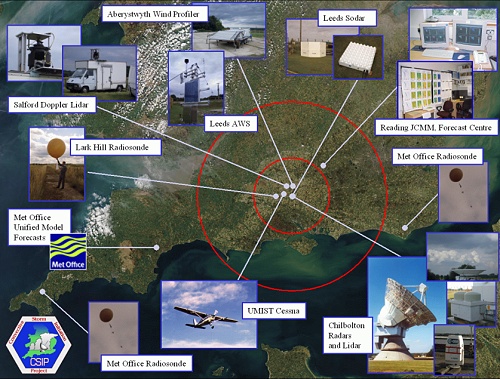CSIP / Convective Storm Initiation Project
- Contact: Dr. N. Kalthoff, Dr. U. Corsmeier, Dr. Ch. Barthlott
- Project Group: IMK-TRO
- Funding: FZK
Project description
Convective Storm Initiation Project (CSIP)
IMK has been invited to contribute to the Convective Storm Initiation Project (CSIP) proposed by the Meteorological community of the UK conducted in southern England in summer 2005.
The problem of forecasting convective precipitation is important because of the increasing amounts of damage being caused by flooding and wind associated with the storms. A number of storms have recently caused substantial flooding and other damage in the UK and other parts of Europe. Convection plays an important part in many flood situations, especially flash floods. Unfortunately the forecasting skill for heavy convective showers and thunderstorms is very low at present. Specifically, the forecast accuracy of a mesoscale model is strongly dependant on the accuracy of the forecast of the initial development.
The goal of CSIP is to understand the mechanisms responsible for the initiation of precipitating convection in the maritime environment of southern England; i.e. to understand why convective clouds form and develop into precipitating clouds in a particular location. Therefore, the realisation and exploitation of a special observational programme involving a consortium of universities which will not only provide better understanding, but will also provide unique datasets for validation and development of mesoscale numerical weather forecast models.
The most poorly understood aspect of forecasting convection is the initiation of new convective cells. There a three key aspects to this problem.
1. What are the localised perturbations in the boundary layer that trigger new convective cells? Candidate processes include horizontal convergence and locally enhanced uplift directly associated with orography, land/sea contrasts, and land-use heterogeneity, as well as variability in temperature and especially moisture, due to variations in surface characteristics and soil moisture, that lead to variability in boundary-layer convection and conditional instability.
2. What are the mesoscale forcing processes in the troposphere that create regions sensitive to triggering ? These will include mesoscale vortices and dry intrusions leading to split frontal structures and regions of conditional instability.
3. How do local modifications of the atmosphere by previous convective cells influence or even dominate over the other perturbations? Convective clouds produce cold pools with associated lifting, as well as tropospheric moisture anomalies and transient static-stability variations due to convectively generated gravity waves.
The project will be centred on the 3 GHz and 1275 clear-air radars at Chilbolton. A number of the new UK Universities' Facility for Atmospheric Measurement mobile instruments will be deployed within the range of the radars. These include three sodars, a Doppler Lidar, a wind profiler, an aerosol and ozone lidar, a network of automatic weather stations, mobile radiosonde stations and a Cessna aircraft. The main project will be conducted in June, July and August 2005. The pilot project was conducted in July 2004.
IMK's contribution to the field campaign includes:
- the research aircraft DO128 equipped for meteorological and chemical measurements
- 2 radiosonde systems
- 2 energy balance stations
- a doppler wind LIDAR
- a cloud radar

Annotated map
The focus of the IMK-activities within CSIP lies on
- statistical investigation of strength, frequency, duration, expansion, and the diurnal cycle above gently rolling terrain in mid latitudes
- scale dependant analysis of processes governing convection initiation
- synoptic scale: vorticity advection, warm and cold air advection, potential instability
- regional scale: land-sea interaction, orographic influence
- local scale: influence of land use, vegetation, soil moisture, convection initiation - numerical simulation of CSIP-cases using different versions of LM
Related Projects:
